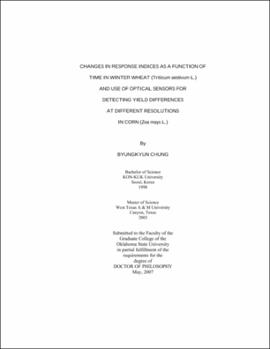| dc.contributor.advisor | Raun, William | |
| dc.contributor.author | Chung, Byungkyun | |
| dc.date.accessioned | 2013-12-10T18:04:32Z | |
| dc.date.available | 2013-12-10T18:04:32Z | |
| dc.date.issued | 2007-05 | |
| dc.identifier.uri | https://hdl.handle.net/11244/7721 | |
| dc.description.abstract | Scope and Method of Study: For chapter one, a study on hard red winter wheat was conducted to determine the nitrogen (N) responsiveness using a response index (RI) as a function of time at 5-locations over a 3-year period. Response index was plotted against days where growing degree days (GDD) were more than zero to determine the ideal stage for predicting RI. Sensor NDVI (normalized difference vegetation index) readings from a non-N limiting strip divided by the farmer practice was used to estimate RINDVI. Subplots (2 m2) were established within five existing long-term trials employing a randomized complete block design. From each plot, GreenseekerTM NDVI sensor readings were collected at various growth stages where RINDVI was subsequently determined. For chapter two, experiments were conducted to determine the optimum resolution for prediction of corn grain yield. Four corn rows, 30 m in length, were randomly selected at three locations in 2004, and 15 m length with 8 rows at two locations in 2005 and 2006. A GreenSeeker optical sensor was used to determine average NDVI across number of plants and over 12 fixed distances. Individual corn plants were harvested and grain yield was determined. Correlation of corn grain yield versus NDVI was evaluated over increasing distances and increasing number of corn plants. | |
| dc.description.abstract | Findings and Conclusions: For chapter one, RINDVI increased with advancing stage of growth. Excluding Stillwater 2006 and Perkins 2005, the relationship between RINDVI and GDD>0 was positive and highly correlated. The relationship between RINDVI and RIHarvest was best described using exponential equations. Averaged over years and sites for all growth stages, the correlation of RINDVI and RIHarvest was positive and increased up to Feekes 8. For chapter two, the linear-plateau model coefficient of determination (R2) was maximized when averaged over every 4-plants in 2004 and 2006, and over 11-plants in 2005. Likewise, R2 was maximized at a fixed distance of 95, 141, and 87 cm in 2004, 2005, and 2006, respectively. Based on the results collected, we recommend 95 cm or alternately, 4-plants as the optimum resolution for detecting early-season differences in yield potential and making management decisions. | |
| dc.format | application/pdf | |
| dc.language | en_US | |
| dc.rights | Copyright is held by the author who has granted the Oklahoma State University Library the non-exclusive right to share this material in its institutional repository. Contact Digital Library Services at lib-dls@okstate.edu or 405-744-9161 for the permission policy on the use, reproduction or distribution of this material. | |
| dc.title | Changes in response indices as a function of time in winter wheat (Triticum aestivum L.) and use of optical sensors for detecting yield differences at different resolutions in corn (Zea mays L.) | |
| dc.contributor.committeeMember | Solie, John B. | |
| dc.contributor.committeeMember | Zhang, Hailin | |
| dc.contributor.committeeMember | Edwards, Jeff | |
| osu.filename | Chung_okstate_0664D_2298 | |
| osu.accesstype | Open Access | |
| dc.type.genre | Dissertation | |
| dc.type.material | Text | |
| thesis.degree.discipline | Plant and Soil Sciences | |
| thesis.degree.grantor | Oklahoma State University | |
